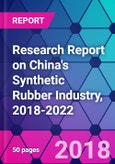According to the researcher, China has become the world's largest producer, consumer and importer of synthetic rubber in recent years. With the acceleration of China's tire industry and infrastructure, industrialized production has been achieved for eight types of synthetic rubber, i.e. styrene butadiene rubber, polybutadiene rubber, chloroprene rubber, nitrile-butadiene rubber, butyl rubber, polyisoprene rubber, ethylene propylene rubber and thermoplastic styrene butadiene rubber. In 2017, the output of synthetic rubber in China reached 5,787,000 tons, increasing by about 3.3% YOY. Synthetic rubbers, including butadiene rubber (BR), styrene butadiene rubber (SBR), nitrile-butadiene rubber (NBR) and SBS thermoplastic elastomers, vary with each other in properties, advantages and disadvantages. For example, China needs to import high-end butadiene rubber such as rare earth butadiene rubber while it has an overcapacity of styrene butadiene rubber. China still needs to import millions of tons of synthetic rubber every year to meet its domestic demand.
According to the researcher, there is a structural overcapacity in China's synthetic rubber industry, the low technical barrier of general synthetic rubber, repeated development of low-end sectors, and homogeneous middle and low-end products. Since the R&D of special synthetic rubber requires huge investment and has high technical barriers, special synthetic rubber in China is mainly imported. As the Chinese government tightens the oversight for environment production, excessive capacity will be gradually eliminated, the industry will be reorganized, and the competition will be fiercer. The main raw material of synthetic rubber is butadiene. Butadiene prices fluctuate with the prices of crude oil and butadiene supply is concentrated in China. Butadiene determines the costs of synthetic rubber to a great extent. As natural rubber and synthetic rubber are substitutes for each other, the demand for synthetic rubber will be affected by natural rubber in the short term. And the price changes of natural rubber and synthetic rubber will be synchronous to some degree. Compared with synthetic rubber, natural rubber has advantages in terms of tensile strength, tear resistance and abrasion resistance. Synthetic rubber has not natural rubber's all advantages at the application end due to limited chemical technologies. However, they satisfy some downstream demand by product diversity.
According to the researcher, the main downstream industry of synthetic rubber and natural rubber is the automotive industry which contributes over 70% of the rubber consumption in China. The main demand field is automobile tires. From 2018 to 2022, China’s tire production will continue to rise and will drive the development of the synthetic rubber industry with the OEM tire demand from expanding automobile production, the tire replacement demand from increasing automobile reserves, and the increase in tire exports.
Topics Covered:
- Development environment of synthetic rubber
- Supply of and demand for synthetic rubber
- Competition in China's synthetic rubber industry
- Major synthetic rubber manufacturers in China
- Production costs and prices of synthetic rubber
- Driving forces and market opportunities for China's synthetic rubber industry from 2018 to 2022
- Prospect of China's synthetic rubber industry from 2018 to 2022
Table of Contents
Companies Mentioned
- Sinopec Qilu Petrochemical Corporation
- YPC-GPRO (Nanjing) Rubber Co., Ltd.
- Shenhua Chemical Industrial Co., Ltd.
- Hangzhou Zhechen Rubber Co., Ltd.
- Fujian Fuxiang Chemical Co., Ltd.
- PetroChina Jilin Petrochemical Company
- PetroChina Fushun Petrochemical Company
- PetroChina Lanzhou Petrochemical Company
- Tianjin Lugang Petroleum Rubber Co., Ltd.
- ExxonMobil Corporation
- Sibur
- Japan Butyl Co. Ltd
- Sinopec Beijing Yanshan Company
- Zhejiang Cenway New Synthetic Materials Co., Ltd.
- Panjin Heyun New Materials Co., Ltd.
- Qingdao Tpi New Material Co., Ltd.
- Shandong Shenchi Chemical Group Co., Ltd.
- Zibo Luhua Hongjin New Material Co., Ltd.
- Qingdao Yikesi New Material Co., Ltd.
Methodology
Background research defines the range of products and industries, which proposes the key points of the research. Proper classification will help clients understand the industry and products in the report.
Secondhand material research is a necessary way to push the project into fast progress. The analyst always chooses the data source carefully. Most secondhand data they quote is sourced from an authority in a specific industry or public data source from governments, industrial associations, etc. For some new or niche fields, they also "double-check" data sources and logics before they show them to clients.
Primary research is the key to solve questions, which largely influence the research outputs. The analyst may use methods like mathematics, logical reasoning, scenario thinking, to confirm key data and make the data credible.
The data model is an important analysis method. Calculating through data models with different factors weights can guarantee the outputs objective.
The analyst optimizes the following methods and steps in executing research projects and also forms many special information gathering and processing methods.
1. Analyze the life cycle of the industry to understand the development phase and space.
2. Grasp the key indexes evaluating the market to position clients in the market and formulate development plans
3. Economic, political, social and cultural factors
4. Competitors like a mirror that reflects the overall market and also market differences.
5. Inside and outside the industry, upstream and downstream of the industry chain, show inner competitions
6. Proper estimation of the future is good guidance for strategic planning.

LOADING...








